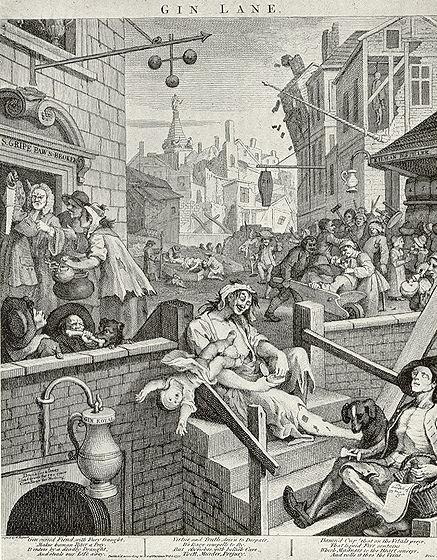"Gin Lane" by William Hogarth
A silver engraving depicts England's Gin Fever

BY 1727, England was consumed with Gin Fever, drinking roughly five million gallons of it a year. “Quite a feat,” notes Denise Winterman of BBC News, “for a population of only six million.”
The origin of Gin Fever dates 1643, when the English Parliament began taxing ale — the predominant drink among citizens. These taxes had gotten so exorbitant by 1690 that people began to dry out, unable to afford their drink of choice. Meanwhile, Parliament was encouraging farmers to grow grain in their fields. Not wanting to guzzle away their money on the ever-increasing ale tariffs, the English found a cheaper way to wet their tongues: turn all that grain into gin.
Gin is much more potent than ale, and people had unlimited access to it — candlemakers even had it in stock. Gin fever had made its mark: It seemed all of England was drunk all of the time. Crimes increased and the amount of people able to make it to their jobs decreased. In 1751, William Hogarth dramatically illustrated the height of Gin Fever in his engraving "Gin Lane."
William Hogarth was 16 when he apprenticed as a silverplate engraver under Ellis Gamble, a goldsmith. At 23, Hogarth started an engraving business of his own. Political satire became his subject of choice, but he also enjoyed producing broader social commentaries. He also painted, and his realistic oils are some of his best-known works. His work became popular, but printers hindered his income by not paying royalties when they used his illustrations. As a result he started the Engraver’s Copyright Act, which Parliament passed into law in 1735. Not everyone praised Hogarth’s artwork; his depictions of governmental authority enraged many political figures. He had a paralytic seizure in 1763, but it didn’t stop him from producing illustrations until his death a year later.
In "Gin Lane," Hogarth’s finely silver-engraved England street scene is filled with people committing atrocities under the influence of gin. Our eyes are drawn first to a limp woman sitting on stairs in the foreground of the illustration. She is so relaxed, in fact, that she has let her baby slip from her arms, headfirst, over a rickety railing, and into the street below. Nobody else in the busy street scene seems to care, or even notice, as they are all busy with their own drunken behavior. Just behind the falling baby, a dog and a small, gaunt-faced man gnaw on a bone together. They sit in front of a pawnshop where people hawk pots, as well as a handheld wood saw. These gin drunkards are occasionally sociable — if only to pour gin down the throat of a friend who is too drunk to do it himself. A woman even pours gin into her child’s mouth from a glass similar to a modern martini glass. Further back in the illustration, a blurry figure can be seen hanging lifelessly from a ceiling beam in the top floor of a ramshackle building. Just beyond that, a structure topples over, brick by brick. An entire coffin hangs from another building: It is a sign for the coroner, the only person faring well in this depiction of Gin Fever. (Courtney Mault)
August 15, 2005 03:01 AM